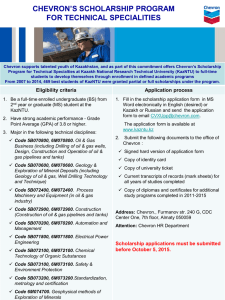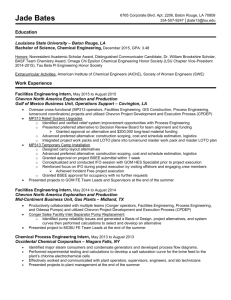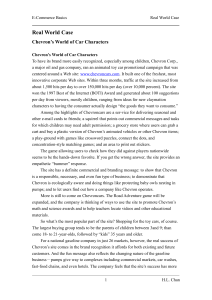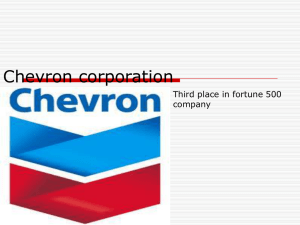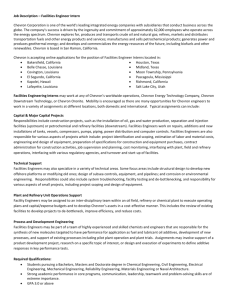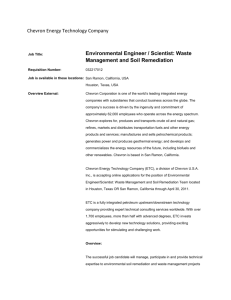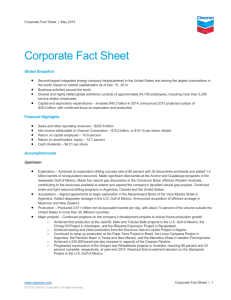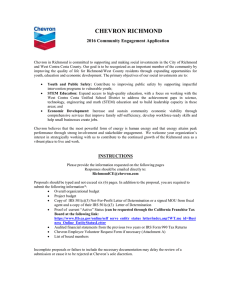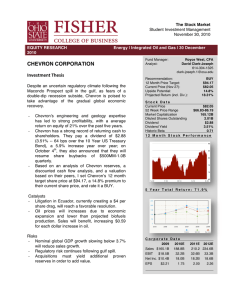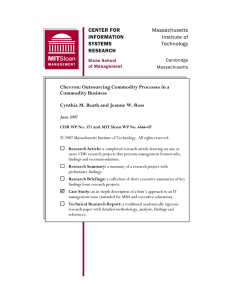CVX
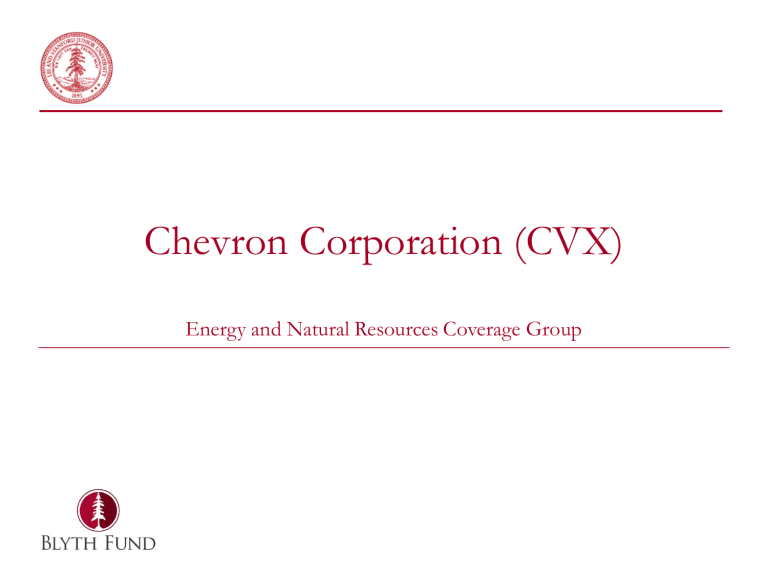
Chevron Corporation (CVX)
Energy and Natural Resources Coverage Group
Company Overview
• Upstream: exploring and developing oil and gas
– Benefits from high oil prices
– Revenue decrease of 18% in
2014
• Downstream: refining and purifying crude resources
– Benefits from low oil prices
– Revenue increase of 93.4% in
2014
Ticker
Price
Market Cap
Dividend
P/E
EPS
CVX
$106.68
$200.58B
$4.28
10.52
$10.14
• John S. Watson - CEO (2010-present)
– 30+ years of experience with the company
– Variety of managerial roles
• George L. Kirkland (2010-present)
– 40+ years at Chevron
– Engineer turned management
– Head of upstream - most important division
• Pierre R. Breber (2014-present)
– 25+ years as engineer and midstream exec
• Overall: seasoned team with relevant industry experience from both corporate and engineering perspectives
Management
Sector Performance
Thesis Summary
• The market has overestimated the damage of the fall in oil prices on global energy players
• Chevron is in the best position amongst these companies to take advantage of depressed energy prices and subsequent recovery
– Has achieved relatives success in vertical integration (especially transportation services) compared to its competitors
– Effective access to cash allows for expansion of oil projects as firms such as BP are forced to consolidate
– Multiple new projects to be brought online, such as the largest enhanced oil recovery project, and extensive technology development
• Price factors
– Lagging demand: slow global growth – China, Japan, Europe
– Will they recover?
– Increased supply: shale etc.
– Price elasticity of supply?
• Uncertain outlook
• Futures ~50% volatility with 95%
C.I. low price $30 and high end $90
• Supply disruptions in major geopolitical players?
– Iran, Venezuela, Russia
Oil Price Prediction
Rebounding Oil Prices
• Companies within OPEC such as Nigeria (whose oil minister is the president of OPEC) incredibly concerned with depressed prices and are currently in talks to organize future action
– Numerous countries such as Venezuela and Russia need higher oil prices to sustain their budgets
• Domestic producers (especially shale) are maintaining or cutting production, which will lead to less supply and higher prices
Vertical Integration Advantage
• Shell and BP have been investigated for antitrust issues in Europe
• Best hedged against ramifications of energy trade war with China (there are likely
Congressional tariffs on business with Chinese subsidiary companies) due to other companies not having majority control of their Chinese subsidiaries
Cash Advantage
• Chevron assumed leadership and partial ownership of multibillion dollar projects in Gila, Tiber, and the Gulf of Mexico from BP in
January
• Chevron has been increasing investments in the deepest areas of the Gulf of Mexico as other companies have continued to cut investment as well as began pumping from sources that have not been used in over a decade
• Chevron was able to raise $6 billion with bonds to help push through the volatility in oil prices
• Suspension of buy-back program will increase available capital for investment
Project and Technology Advantage
• Manages the world’s largest hyper-efficient, enhanced oil recovery extraction project
– Led to sell off when announced, but critical in in growing market share once oil markets normalize
• Had one of its best exploration years, with important discoveries in the deepwater
Gulf of Mexico, Australia, West Africa and the Permian Basin
• Recently brought a new deep-water oil platform online
– Expected to produce 94,000 barrels per day of oil/21 million cubic feet of natural gas.
• Can generate that 10% breakeven even at oil prices as low as $30 per barrel, and production is forecasted to increase 20% from 2013 industry benchmarks by 2017
• Chevron Technology Ventures is over a decade old and currently has invested over $200 million in start ups and other emerging technologies
Thesis Summary
• The market has overestimated the damage of the fall in oil prices on global energy players
• Chevron is in the best position amongst these companies to take advantage of depressed energy prices and subsequent recovery
– Has achieved relatives success in vertical integration (especially transportation services) compared to its competitors
– Effective access to cash allows for expansion of oil projects as firms such as BP are forced to consolidate
– Multiple new projects to be brought online, such as the largest hyper-efficient oil extraction project, and extensive technology development
Comps Model
Company Ticker Price
Chevron
ExxonMobil
CVX
XOM
$106.68
$88.54
Shell RDS $65.37
BP BP $41.44
ConocoPhillips COP $64.40
Market
Cap
P/E
$200.58B
10.52
$371.40B
11.66
$205.75B
13.87
$125.70B
33.86
$79.31B
11.69
1.3
2.14
1.19
1.13
1.55
P/B Dividend
Yield
4.00%
3.10%
4.70%
5.80%
4.50%
EV/EBITDA
5.90
7.06
5.18
5.28
5.00
Company
Chevron
ExxonMobil
Shell
BP
ConocoPhillips
Ticker Cash
CVX
XOM
RDS
BP
COP
$13.22B
$4.62B
$21.61B
$30.09B
$5.06B
Debt
More Comparatives
$27.82B
$29.12B
$45.54B
$52.85B
$22.56B
Debt/Equity
17.81
16.08
26.36
46.92
43.17
Exploration Failure
Rate
(Last reported year)
30%
39%
N/A
53%
N/A
• Tied to the uncertain oil market
• Downside risk
– Dip into cash reserve?
– Dividend impact?
– Future exploration projects affected by lower per barrel prices
• Ceiling for the foreseeable future?
– CVX vs market expectations
Risk Factors
Why aren’t we worried about Chevron?
• Well-positioned for decline in oil prices
– No real risk of dividend decline
– Ramifications of decline for smaller producers
– Cash on hand
• Not a short-term play
– Dividend in the interim
Downstream Hedge
• In the downstream, CVX completed important investments at
U.S. refineries, which contributed to improved financial and operational performance.
1. New premium lubricants base oil facility in Mississippi.
2. Expansion of additives plants in Singapore and France.
3. Chevron Phillips Chemical Company LLC, achieved startup of the world’s largest on-purpose 1-hexene plant and progressed construction of its new ethane cracker and polyethylene units in Texas.
Downstream
10%
2013
Downstream
20%
Earnings
2014
Upstream
80%
Upstream
90%
Discounted Cash Flow
Targets
• Target price: oil breaks $70/barrel, stock price around $122
• Exit if: oil drops below $35/barrel
• Timeline: 2-2.5 years
